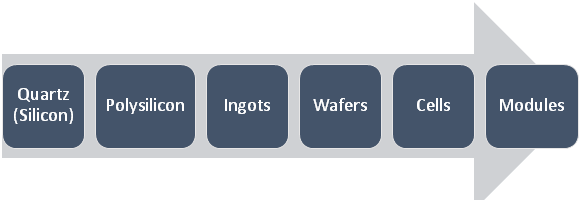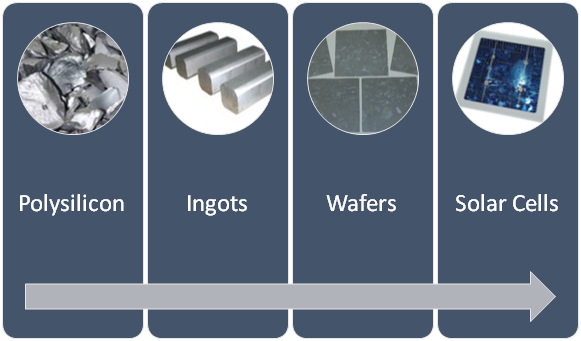We know that crystalline solar cells are typically made from silicon.
We need to process silicon into solar cells. Ingot manufacturing comes in between the transformation of silicon to solar-grade finished solar cells.
| Ingots are processed from polysilicon and acts as the intermediate stage between polysilicon and wafers. |

Initially polysilicon is refined into either single crystal polysilicon (Mono-Crystalline polysilicon) or Multi-Crystalline (also called polycrystalline) polysilicon.
Polysilicon is transformed to ingots by an industrial baseline process called the Siemens Process (Czochralski Process).In this process, large blocks of silicon are melted in a high purity crucible around 1500 degrees Celsius. A pure silicon rod, known as seed crystal, is then dipped in the molten silicon from the end of a rotating shaft. The shaft rotates anti-clockwise and the crucible rotates clockwise. The rotating rod is then drawn upwards and a uniform deposition of silicon is obtained. By precisely controlling the temperature gradients, rate of pulling the rod and the speed of rotation, it is possible to extract a large, single-crystal cylindrical ingot.
The specifics of the crucible design allow the ingot to cool slowly so that very large grains (> 1 cm) are formed. Growing a silicon ingot can take anywhere from one to week to one month, depending on the size, quality and the specifications required.
What is interesting is that the ingot production takes up around one-third the cost of solar cell production. It is a capital intensive process. Since production costs scale favourably with size, ingot weights have continuously increased from 270 Kg a few years ago to 700 Kg now.
After the silicon ingots are ground to the required diameters, they are sliced into wafers. The slicing is done with great precision using diamond saws. These wafers then transform into electricity-producing solar cells.


 Skip to content
Skip to content
